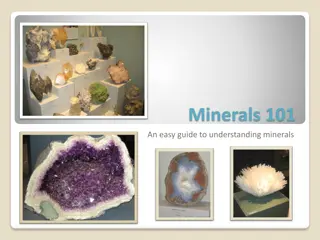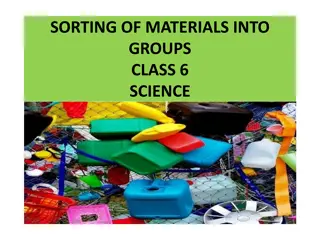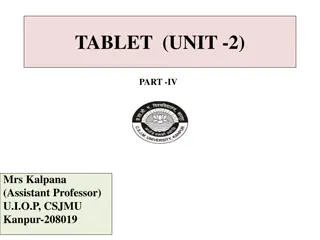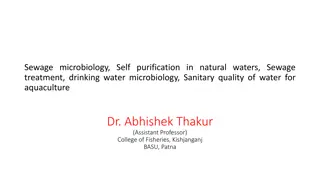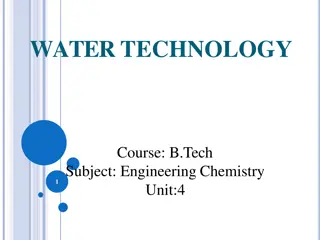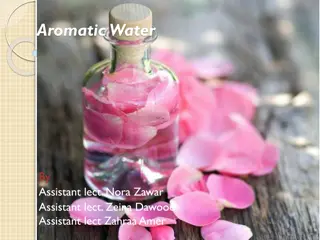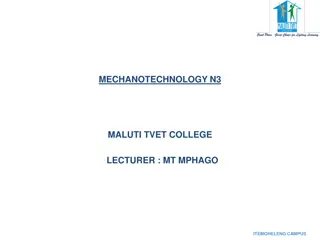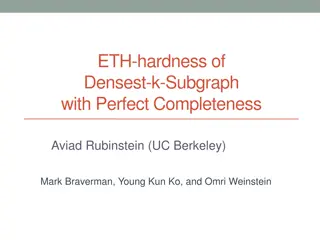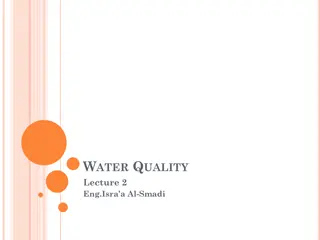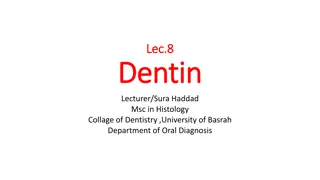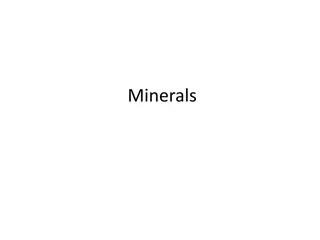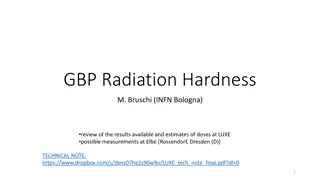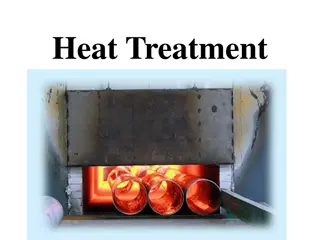Understanding Water Hardness and Treatment Methods
Water plays a crucial role in the food industry, particularly in the dairy sector. This article explores the types of water, focusing on hard and soft water, and discusses temporary and permanent hardness. It also delves into various treatments for water hardness, such as the cold lime method, base exchange softening method, demineralization, filtration, and chlorination. Ensuring the quality of water is essential for maintaining the integrity of food products and processes.
Download Presentation

Please find below an Image/Link to download the presentation.
The content on the website is provided AS IS for your information and personal use only. It may not be sold, licensed, or shared on other websites without obtaining consent from the author. Download presentation by click this link. If you encounter any issues during the download, it is possible that the publisher has removed the file from their server.
E N D
Presentation Transcript
SOFT AND HARD WATER, TEMPORARY AND PERMANENT HARDNESS, Treatments of water DTC-311 (Chemical Quality Assurance) Binod Kumar Bharti Assistant Professor cum Jr. Scientist Department of Dairy Chemistry S.G.I.D.T. (BASU) Patna
Contents 1. Introduction 2. Types of Water 3. Treatments of water a. Cold lime method b. Base exchange softening method c. Demineralizing (Deionizing) water supplies c. Filtration d. Reverse osmosis systems 4. Chlorination 5. Conclusion
Introduction Water as an essential nutrient is second only to oxygen in importance to sustain life and optimize growth, lactation, and reproduction of dairy cattle. Water is a basic renewable natural resource upon which the survival and well being of living organisms depend. Water is also essential to the food supply and habitat of all other living organisms. The food industry uses large quantities of water. It is the most necessary item of the dairy and food industry.
Uses of water- Water is used for generating steam, cleaning, grading, and conveying products, as a heat exchange medium in heating and cooling operations, for cleaning plant and equipment, for condensing vapors, for the fire protection, sanitizing, drinking, as an ingredient in the finished products and as a waste disposal.
Water plays a versatile role in food industry, so water must be in adequate supply, safer and of high quality. The supply of adequate quantity and safe quality of water is of vital importance to the food industry particularly to dairy industry. Management of water in food industry consists of three main components such as i) quality at entry level, ii) water conservation and iii) waste management.
Types of Water Normally water is classified into two groups- i) Hard water and ii) Soft water. Water hardness is due to the presence of di- cations including Ca2+ and Mg2+. Water hardness is further classified into two types: i) Temporary hardness and ii) Permanent hardness.
Temporary hardness Temporary hardness is mainly caused by the carbonates and bicarbonates of calcium and magnesium. It can be easily removed by boiling of water. Permanent hardness Permanent hardness is due to presence of sulfates and chlorides of calcium and magnesium in water. Permanent hardness is not removed by simple boiling of water but it requires some complex operations.
The combined effect of temporary and permanent hardness is called as total hardness of the water. Temporary hardness is also known as carbonate hardness and permanent hardness is also known as non- carbonate hardness. Conventionally hardness of water is expressed in terms of ppm of calcium carbonate.
In Dairy and food industry, the major problem caused by hard water is the deposition of scales in and on the pipes which can clog plumbing and interfere with heat exchangers. These scale problem, are caused mainly of calcium carbonate (CaCO3), magnesium hydroxide [Mg(OH)2], and calcium sulfate (CaSO4). Calcium and magnesium carbonates tend to precipitate out as hard deposits to the surfaces of pipes and heat exchanger surfaces. In boilers, the deposits act as an insulation that damages the flow of heat into water, reducing the heating efficiency and allowing the metal boiler components to overheat.
The following equilibrium reaction refer to the formation of calcium carbonate scales CaCO3 + CO2 + H2O Ca2+ + 2HCO3- Hard water, form white precipitate with soap solutions, instead of producing lather. This effect arises because the di- cations destroy the surfactant properties of the soap by forming a solid precipitate.
Physical and Chemical tolerances (BIS, 1981) Sl. No. 1 Characteristics Turbidity (units) max. Tolerance 10 2 Odour None 3 pH 6.5-9.2 4 Total Solid (mg/L), max. 1000 5 Total hardness (as CaCO3), mg/L max. 600 6 Sulphate (as So3), mg/L, max. 200 7 Fluoride (as F), mg/, max. 1.5 8 Chloride (as Cl), mg/L, max. 250 9 Iron (as Fe), mg/L, max. 0.3 10 Arsenic (as As), mg/l, max 0.2 11 Mercury (Hg), mg/L, max. 0.001
Additional tolerances for specific operations CaCO3), mg/L, max Characteristics Tolerance for Total Hardness (as Cooling Washing, flushing and general purpose Processing 30 30 - Iron (as Fe), mg/L, max - 0.1 0.1 Manganese (as Mn), mg/L, max - -
Water treatment is the process of making water suitable or acceptable for an end-use. It removes existing water contaminants and so reduces their concentration that the water becomes fit for its desired application. The amount & type of treatment process (Treatment Train ) depends upon quality of raw water and various standards required after treatment.
SOFTENING OF HARD WATER Dairy and Food processors always treat at least some of the water used in the plants. This is due to the special requirements for use in boilers, cooling towers, heat exchanger and similar equipment. Treatment of water may be done to control corrosion and formation of scale on equipment, to remove the turbidity caused by solids, to eliminate staining, odor and flavor problems, and also to assure safety for consumption. Satisfactory procedure for water supply may be inadequate for another. Designing a water treatment system for a food plant must be considered on an individual plant basis.
Turbidity-Solids Removed Turbidity process results from suspended particles in water. The particles may range in size from 100,000 millimicrons in diameter for fine sand to colloidal suspensions with particle sizes between 1 to 200 millimicrons. To produce clear water, removal of particles in colloidal suspension is usually essential. Since colloidal suspensions are relatively stable, a coagulant is used to cause aggregation of particles of sufficiently high density to promote settling out for clarification. Some inorganic chemicals are used as coagulants are Ferric sulfate, Ferrous sulfate, Filter alum, Sodium aluminate.
Softening Softening of water is done to remove the hardness of water due to deposition of minerals. Different methods are applied for water softening as: 1. Cold lime method 2. Base exchange softening method 3. Demineralizing (Deionizing) water supplies 4. Filtration 5. Reverse osmosis (RO) system
Functions of Water Treatment Units Unit Treatment Function (Removal) Aeration, chemical use Colour, Odour, Taste Screening Floating matter Chemical methods Iron, manganese Softening Hardness Sedimentation Suspended matter Coagulation Suspended matter, a part of colloidal matter and bacteria Filtration Remaining colloidal dissolved matter and bacteria Disinfection Pathogenic bacteria, Organic matter and reducing substance
1. Cold lime method Many municipal water treatment plants use the cold lime softening method. In this method, calcium oxide (CaO) is added to the hard water to form calcium hydroxide, which reacts with magnesium and calcium bicarbonates and free CO2 to form insoluble calcium carbonate and magnesium hydroxide. Magnesium hydroxide is used a good flocculating agent which aids in precipitating the calcium carbonate particles. This treatment will usually result in water with about 70 to 85 ppm of calcium (4 to 5 grains per gallon) when discharged from the final filtration unit. Sand and gravel filters are commonly used for removing the precipitated salts by the cold lime softening method.
2. Base exchange softening method Most food plants uses the base-exchange process for softening the water for cleaning and other uses. The main materials used in the ion exchange are natural or synthetic zeolites which often are hydrous silicate or styrene based resins. Mostly Sodium zeolite softening is use of ion exchange. In zeolite softening, water containing scale-forming ions, like calcium and magnesium, it passes through a resin bed containing strong Acid Cation resin in the sodium form. Softening water with a sodium cycle ion-exchanger is most commonly found in processing plants.
3. Demineralizing (Deionizing) water supplies The demineralized (deionized) water treatments are used for beverage industry. Several variations are found in demineralization systems depending on the analysis of the untreated water and the desired purity of the treated water. Systems for demineralizing water are basically of two types- multi- bed and mixed-bed. Mixed-bed units offer the advantage of less space required, and they will also produce high quality water. Multi-bed and mixed-bed ion ex-changers are sometimes sequenced into a system to produce very high quality demineralized water.
4. Filtration Filtering is almost common methods in a water treatment system. In many cases, water is filtered before softening or demineralizing process. It depending upon the system and quality of water desired, the final step may be filtration. Large water treatment plants for municipalities will regularly use by gravity type filters. Generally, food processing plants will usually find the enclosed pressure type filters with more satisfactory.
5.Reverse osmosis systems The reverse osmosis (RO) technology is advancing rapidly. Reverse osmosis separates one component of a solution from another by placing the solution under pressure against a semi permeable membrane. Normally the pores of the semi permeable membranes used in RO are 5 to 20 Angstrom units (5 to 20 x 10-8 cm) in diameter. A number of membranes have been developed, and generally cellulose acetate is used. Reverse osmosis is a method of purifying water to a high degree, especially when used in conjunction with a prefilter and an ion- exchanger. Advantages- Chemicals are unnecessary, membrane life is normally 1-3 years, low maintenance requirements, pressure is the only energy requirement.
Chlorination of Water Supplies Addition of small amounts of chlorine to water supplies acts as a safeguard against water-borne diseases. Food processing plants unit have increasingly been chlorinating water to improve sanitation. Chlorine may be added to water systems in food plants as type of gas or as a solution of chlorine compounds which are mainly hypo chlorites of sodium or calcium. Some plant operators have found chlorine dioxide to be very satisfactory where considerable organic matter is present, such as in recycled water systems.
Chlorine Dose rates for specific purposes Purpose of water Dose rate (ppm) Well 1.5 Surface 110 cooling 3-5 chilling 20 Washing 50
Conclusion Water is an essential to the food supply and habitat of all other living organisms. The dairy and food industry uses large quantities of water. Water is used for generating steam, for cleaning plant and equipment, for condensing vapors, for sanitizing, for drinking, for waste disposal etc. Generally, Hard water and Soft water are found. Water hardness is due to the presence of di- cations including Ca2+ and Mg2+. Temporary hardness is mainly caused by the carbonates and bicarbonates of calcium and magnesium. It can be easily removed by boiling of water. Permanent hardness is due to presence of sulfates and chlorides of calcium and magnesium in water. It can not removed by simple boiling of water but it requires some complex operations. There are various methods are uses for treatments of hard water such as cold lime, Base exchange softening, Demineralizing (Deionizing) water supplies, Filtration, Reverse osmosis (RO) system and chlorination methods.






